45 understanding food labels uk
› government › publicationsFood teaching in secondary schools: knowledge and ... - GOV.UK Nov 19, 2015 · Support for secondary schools to implement the requirements for food teaching within the new National Curriculum for Design and Technology (D&T) in England, the GCSE Food Preparation and Nutrition ... › how-to-recycle › understandingUnderstanding recycling symbols | Recycle Now As local authorities do not all collect the same materials, the labels are based on what the majority collect, or do not collect. If in doubt, enter your postcode into our Recycling Locator tool to find out what you can put in your home recycling bin and how to recycle specific items such as mobile phones and textiles.
› sites › defaultGuide to creating a front of pack ... - Food Standards Agency This section provides supporting information to help organisations from within the food industry, health and consumer non-governmental organisations, or professional bodies and companies working in diet and nutrition to promote, and explain to consumers how to use, the UK Government’s recommended Front of Pack Nutrition labelling scheme.

Understanding food labels uk
indianexpress.com › article › lifestyleNatural vs organic foods: Understanding the basic differences Jul 21, 2022 · Coutinho highlighted that the words “natural”, and “organic” may sound the same but are different. “Organic products are grown without the use of synthetic chemicals, such as conventional pesticides and fertilisers and do not contain genetically modified organisms (GMOs), while natural products don’t promise all of this but may be free of synthetic or artificial ingredients or ... › advice › triggersFood as an asthma trigger | Asthma UK - Asthma + Lung UK Food allergies. Although a lot of food allergies start in childhood, you can develop them as an adult too. Some of the most common food allergens are gluten (from wheat and cereal products), shellfish, eggs, milk, tree nuts, peanuts, sesame seeds, and soya. Some food allergies, such as allergies to milk and eggs, are more common in children. › safety-hygiene › best-before-andBest before and use-by dates | Food Standards Agency We can’t see or smell the bugs that can cause food poisoning. Manufacturers are responsible for deciding whether to apply a use by date or a best before date on their products. This will depend on factors such as how the food is made and how risky it is. They will make sure the right label is used on the product. Always check the date labels ...
Understanding food labels uk. › understanding-food-labelsUnderstanding food labels | Diabetes UK The labels show how many calories are in the food or drink and are also colour coded to show whether the food is low (green), medium (amber) or high (red) in fat, saturated fat, sugar and salt. The information on the front of the pack also tells you how the portion of the food contributes to the Reference Intake (RI) of an adult. › safety-hygiene › best-before-andBest before and use-by dates | Food Standards Agency We can’t see or smell the bugs that can cause food poisoning. Manufacturers are responsible for deciding whether to apply a use by date or a best before date on their products. This will depend on factors such as how the food is made and how risky it is. They will make sure the right label is used on the product. Always check the date labels ... › advice › triggersFood as an asthma trigger | Asthma UK - Asthma + Lung UK Food allergies. Although a lot of food allergies start in childhood, you can develop them as an adult too. Some of the most common food allergens are gluten (from wheat and cereal products), shellfish, eggs, milk, tree nuts, peanuts, sesame seeds, and soya. Some food allergies, such as allergies to milk and eggs, are more common in children. indianexpress.com › article › lifestyleNatural vs organic foods: Understanding the basic differences Jul 21, 2022 · Coutinho highlighted that the words “natural”, and “organic” may sound the same but are different. “Organic products are grown without the use of synthetic chemicals, such as conventional pesticides and fertilisers and do not contain genetically modified organisms (GMOs), while natural products don’t promise all of this but may be free of synthetic or artificial ingredients or ...

Food labels are an important source of information about the food and thus printing of food ...








.jpg?itok=H6LqJmiT)
/arc-anglerfish-tgam-prod-tgam.s3.amazonaws.com/public/C6KP5YSHXVHYVMFK6ZG6RTC2CI)


Post a Comment for "45 understanding food labels uk"